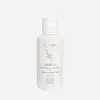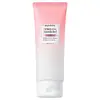Ellana Mineral Cosmetics Gentle Milky Oil Cleanser & Makeup Remover Versus Skintific Zero Oil Cleansing Balm
What's inside
What's inside
 Key Ingredients
Key Ingredients

 Benefits
Benefits

 Concerns
Concerns

 Ingredients Side-by-side
Ingredients Side-by-side

Water
Skin ConditioningCaprylic/Capric Triglyceride
MaskingCetyl Alcohol
EmollientGlyceryl Stearate
EmollientPEG-75 Stearate
Ceteth-20
CleansingSteareth-20
CleansingPEG-7 Glyceryl Cocoate
EmulsifyingGlycerin
HumectantPhenoxyethanol
PreservativeEthylhexylglycerin
Skin ConditioningPanthenol
Skin ConditioningOlive Glycerides
EmulsifyingCalophyllum Inophyllum Seed Oil
AntimicrobialCeramide NP
Skin ConditioningPropylene Glycol
HumectantRosa Canina Bud Extract
Skin ConditioningAllantoin
Skin ConditioningGuar Hydroxypropyltrimonium Chloride
Skin ConditioningWater, Caprylic/Capric Triglyceride, Cetyl Alcohol, Glyceryl Stearate, PEG-75 Stearate, Ceteth-20, Steareth-20, PEG-7 Glyceryl Cocoate, Glycerin, Phenoxyethanol, Ethylhexylglycerin, Panthenol, Olive Glycerides, Calophyllum Inophyllum Seed Oil, Ceramide NP, Propylene Glycol, Rosa Canina Bud Extract, Allantoin, Guar Hydroxypropyltrimonium Chloride
Water
Skin ConditioningPEG-7 Glyceryl Cocoate
EmulsifyingGlycerin
HumectantIsononyl Isononanoate
EmollientCoco-Caprylate/Caprate
EmollientC13-16 Isoparaffin
SolventSodium Carbomer
Emulsion StabilisingPolyglyceryl-10 Laurate
Skin ConditioningPolyglyceryl-10 Myristate
Skin ConditioningCetraria Islandica Extract
CleansingHydroxyacetophenone
AntioxidantPolyglyceryl-6 Dicaprate
EmulsifyingAlgae Extract
EmollientDisodium EDTA
Ethylhexylglycerin
Skin ConditioningMaltodextrin
AbsorbentLecithin
EmollientXanthan Gum
EmulsifyingPhenoxyethanol
PreservativeSodium Benzoate
MaskingPotassium Sorbate
PreservativeAroma
Water, PEG-7 Glyceryl Cocoate, Glycerin, Isononyl Isononanoate, Coco-Caprylate/Caprate, C13-16 Isoparaffin, Sodium Carbomer, Polyglyceryl-10 Laurate, Polyglyceryl-10 Myristate, Cetraria Islandica Extract, Hydroxyacetophenone, Polyglyceryl-6 Dicaprate, Algae Extract, Disodium EDTA, Ethylhexylglycerin, Maltodextrin, Lecithin, Xanthan Gum, Phenoxyethanol, Sodium Benzoate, Potassium Sorbate, Aroma
 Reviews
Reviews

Ingredients Explained
These ingredients are found in both products.
Ingredients higher up in an ingredient list are typically present in a larger amount.
Ethylhexylglycerin (we can't pronounce this either) is commonly used as a preservative and skin softener. It is derived from glyceryl.
You might see Ethylhexylglycerin often paired with other preservatives such as phenoxyethanol. Ethylhexylglycerin has been found to increase the effectiveness of these other preservatives.
Glycerin is already naturally found in your skin. It helps moisturize and protect your skin.
A study from 2016 found glycerin to be more effective as a humectant than AHAs and hyaluronic acid.
As a humectant, it helps the skin stay hydrated by pulling moisture to your skin. The low molecular weight of glycerin allows it to pull moisture into the deeper layers of your skin.
Hydrated skin improves your skin barrier; Your skin barrier helps protect against irritants and bacteria.
Glycerin has also been found to have antimicrobial and antiviral properties. Due to these properties, glycerin is often used in wound and burn treatments.
In cosmetics, glycerin is usually derived from plants such as soybean or palm. However, it can also be sourced from animals, such as tallow or animal fat.
This ingredient is organic, colorless, odorless, and non-toxic.
Glycerin is the name for this ingredient in American English. British English uses Glycerol/Glycerine.
Learn more about GlycerinPeg-7 Glyceryl Cocoate is created from polyethylene glycol and fatty acids from coconut oil.
It is a synthetic polymer with emulsifying and cleansing properties.
As an emulsifier, Peg-7 Glyceryl Cocoate prevents ingredients such as oils and water from separating. It also helps rinse away oils, dirt, and pollutants from skin.
Peg-7 Glyceryl Cocoate may not be fungal acne safe. It can also dry out skin.
Learn more about PEG-7 Glyceryl CocoatePhenoxyethanol is a preservative that has germicide, antimicrobial, and aromatic properties. Studies show that phenoxyethanol can prevent microbial growth. By itself, it has a scent that is similar to that of a rose.
It's often used in formulations along with Caprylyl Glycol to preserve the shelf life of products.
Water. It's the most common cosmetic ingredient of all. You'll usually see it at the top of ingredient lists, meaning that it makes up the largest part of the product.
So why is it so popular? Water most often acts as a solvent - this means that it helps dissolve other ingredients into the formulation.
You'll also recognize water as that liquid we all need to stay alive. If you see this, drink a glass of water. Stay hydrated!
Learn more about Water